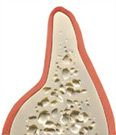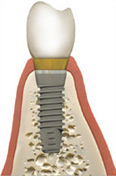Allograft
Most dental bone grafting procedures are done to restore bone to its original form following tooth loss, gum disease or trauma. It may also be used to maintain the boney ridge after tooth extraction.
Restoring and maintaining facial bone structure is important for several reasons. Many dental procedures, such as implant placement, require that the bone be as close to its original dimension and position as possible for optimal results. Also, the jaw and other facial bones support the skin and muscle that are responsible for our outward cosmetic appearance. Without the support of the underlying bone, our faces can look prematurely aged.
The success of a dental implant and its ability to support a dental restoration is dependent upon the quantity and quality of available bone at the implant site. When a patient lacks sufficient bone to adequately support an implant(s) we have the ability to grow bone where needed. Bone grafting procedures have become an integral part of implant reconstruction and your doctor will explain to you if you will need bone grafting. Allograft bone is material taken from an organ donor and processed to ensure its safety and improve the handling characteristics. Allograft bone is available in unlimited quantities and does not require a second procedure to harvest it. Allograft bone has been well documented in clinical trials and has an excellent safety record.
Benefits of allograft bone
- No second surgical (harvest) site
- Available in vast quantities
- Clinically proven effectiveness
- Great track record of safety




